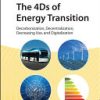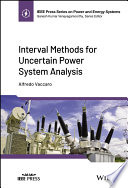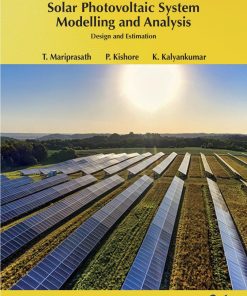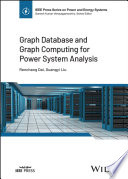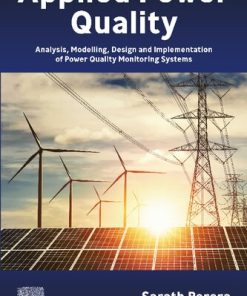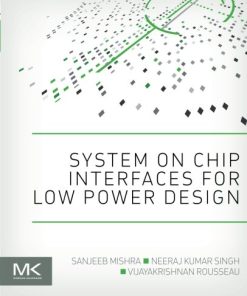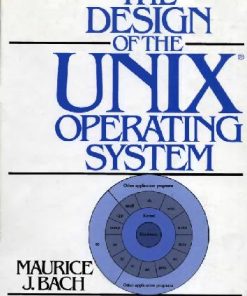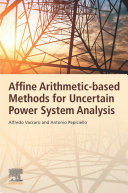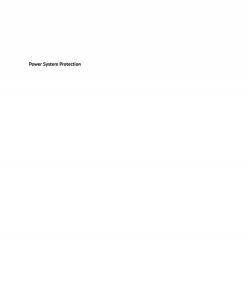Power System Analysis and Design 6th Edition by Duncan Glover, Thomas Overbye, Mulukutla Sarma 9798214350622
$50.00 Original price was: $50.00.$25.00Current price is: $25.00.
Power System Analysis and Design 6th Edition by J. Duncan Glover, Thomas Overbye, Mulukutla S. Sarma – Ebook PDF Instant Download/DeliveryISBN: 9798214350622
Full download Power System Analysis and Design 6th Edition after payment.
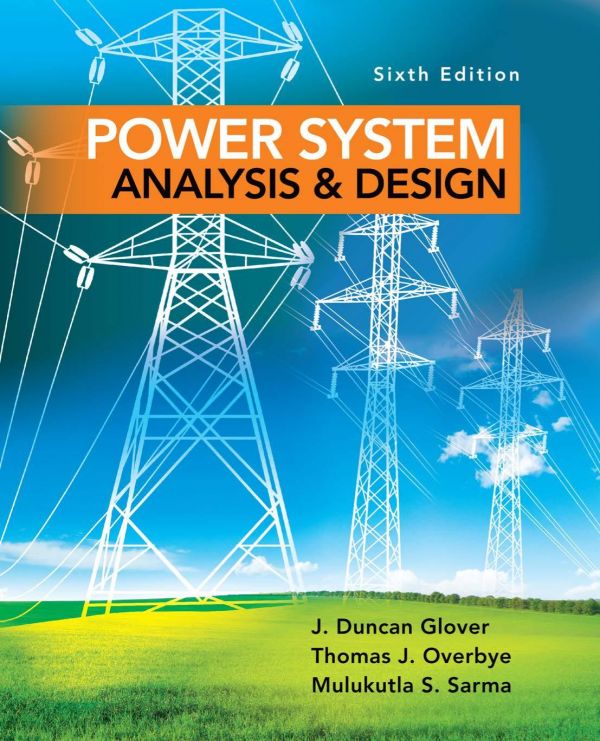
Product details:
ISBN-13 : 9798214350622
Author : J. Duncan Glover, Thomas Overbye, Mulukutla S. Sarma
Learn the basic concepts of power systems along with the tools you need to apply these skills to real world situations with POWER SYSTEM ANALYSIS AND DESIGN, 6E. This new edition highlights physical concepts while also giving necessary attention to mathematical techniques. The authors develop both theory and modeling from simple beginnings so that you can readily extend these principles to new and complex situations. Software tools, including PowerWorld® Simulation, and the latest content throughout this edition aid you with design issues while introducing you to the most recent trends in the field today.
Power System Analysis and Design 6th Table of contents:
Chapter 1. Introduction
1.1. History of Electric Power Systems
1.2. Present and Future Trends
1.3. Electric Utility Industry Structure
1.4. Computers in Power System Engineering
1.5. PowerWorld Simulator
References
Chapter 2. Fundamentals
2.1. Phasors
2.2. Instantaneous Power in Single-Phase AC Circuits
Purely Resistive Load
Purely Inductive Load
Purely Capacitive Load
General RLC Load
Real Power
Power Factor
Reactive Power
Physical Significance of Real and Reactive Power
2.3. Complex Power
2.4. Network Equations
2.5. Balanced Three-Phase Circuits
Balanced Y Connections
Balanced Line-To-Neutral Voltages
Balanced Line-to-Line Voltages
Balanced Line Currents
Balanced- Δ Loads
Δ – Y Conversion for Balanced Loads
Equivalent Line-To-Neutral Diagrams
2.6. Power in Balanced Three-Phase Circuits
Instantaneous Power: Balanced Three-Phase Generators
Instantaneous Power: Balanced Three-Phase Motors and Impedance Loads
Complex Power: Balanced Three-Phase Generators
Complex Power: Balanced Three-Phase Motors
Complex Power: Balanced-Y and Balanced- Δ Impedance Loads
2.7. Advantages of Balanced Three-Phase versus Single-Phase Systems
Multiple Choice Questions
Problems
Case Study Questions
References
Chapter 3. Power Transformers
3.1. The Ideal Transformer
3.2. Equivalent Circuits for Practical Transformers
Saturation
Inrush Current
Nonsinusoidal Exciting Current
Surge Phenomena
3.3. The Per-Unit System
3.4. Three-Phase Transformer Connections and Phase Shift
3.5. Per-Unit Equivalent Circuits of Balanced Three-Phase Two-Winding Transformers
3.6. Three-Winding Transformers
3.7. Autotransformers
3.8. Transformers with Off-Nominal Turns Ratios
Multiple Choice Questions
Problems
Case Study Questions
References
Chapter 4. Transmission Line Parameters
4.1. Transmission Line Design Considerations
Conductors
Insulators
Support Structures
Shield Wires
Electrical Factors
Mechanical Factors
Environmental Factors
Economic Factors
4.2. Resistance
4.3. Conductance
4.4. Inductance: Solid Cylindrical Conductor
4.5. Inductance: Single-Phase Two-Wire Line and Three-Phase Three-Wire Line with Equal Phase Spacing
4.6. Inductance: Composite Conductors, Unequal Phase Spacing, Bundled Conductors
4.7. Series Impedances: Three-Phase Line with Neutral Conductors and Earth Return
4.8. Electric Field and Voltage: Solid Cylindrical Conductor
4.9. Capacitance: Single-Phase Two-Wire Line and Three-Phase Three-Wire Line with Equal Phase Spacing
4.10. Capacitance: Stranded Conductors, Unequal Phase Spacing, Bundled Conductors
4.11. Shunt Admittances: Lines with Neutral Conductors and Earth Return
4.12. Electric Field Strength at Conductor Surfaces and at Ground Level
4.13. Parallel Circuit Three-Phase Lines
Multiple Choice Questions
Problems
Case Study Questions
References
Chapter 5. Transmission Lines: Steady-State Operation
5.1. Medium and Short Line Approximations
5.2. Transmission-Line Differential Equations
5.3. Equivalent π Circuit
5.4. Lossless Lines
Surge Impedance
ABCD Parameters
Equivalent π Circuit
Wavelength
Surge Impedance Loading
Voltage Profiles
Steady-State Stability Limit
5.5. Maximum Power Flow
5.6. Line Loadability
5.7. Reactive Compensation Techniques
Multiple Choice Questions
Problems
Case Study Questions
References
Chapter 6. Power Flows
6.1. Direct Solutions to Linear Algebraic Equations: Gauss Elimination
6.2. Iterative Solutions to Linear Algebraic Equations: Jacobi and Gauss-Seidel
6.3. Iterative Solutions to Nonlinear Algebraic Equations: Newton-Raphson
6.4. The Power Flow Problem
6.5. Power Flow Solution by Gauss-Seidel
6.6. Power Flow Solution by Newton-Raphson
6.7. Control of Power Flow
6.8. Sparsity Techniques
6.9. Fast Decoupled Power Flow
6.10. The “DC” Power Flow
6.11. Power Flow Modeling of Wind Generation
6.12. Economic Dispatch
Fossil-Fuel Units, No Inequality Constraints, No Transmission Losses
Effect of Inequality Constraints
Effect of Transmission Losses
Other Types of Units
6.13. Optimal Power Flow
Multiple Choice Questions
Problems
Case Study Questions
Design Project I: New Load
Design Project 2: New Wind Generation and Generation Retirement
Design Projects 1 and 2: Sample Transmission System Design Costs
Design Project 3: Power Flow/Short Circuits
References
Chapter 7. Symmetrical Faults
7.1. Series R–L Circuit Transients
7.2. Three-Phase Short Circuit—Unloaded Synchronous Machine
7.3. Power System Three-Phase Short Circuits
7.4. Bus Impedance Matrix
7.5. Circuit Breaker and Fuse Selection
AC Circuit Breakers
Fuses
Multiple Choice Questions
Problems
Case Studies Questions
Design Project 3 (Continued): Power Flow/Short Circuits
References
Chapter 8. Symmetrical Components
8.1. Definition of Symmetrical Components
8.2. Sequence Networks of Impedance Loads
Diagonal Sequence Impedances
Off-Diagonal Sequence Impedances
8.3. Sequence Networks of Series Impedances
8.4. Sequence Networks of Three-Phase Lines
8.5. Sequence Networks of Rotating Machines
8.6. Per-Unit Sequence Models of Three-Phase Two-Winding Transformers
8.7. Per-Unit Sequence Models of Three-Phase Three-Winding Transformers
8.8. Power in Sequence Networks
Multiple Choice Questions
Problems
Case Studies Questions
References
Chapter 9. Unsymmetrical Faults
9.1. System Representation
9.2. Single Line-to-Ground Fault
9.3. Line-to-Line Fault
9.4. Double Line-to-Ground Fault
9.5. Sequence Bus Impedance Matrices
Balanced Three-Phase Fault:
Single Line-to-Ground Fault (Phase a to Ground):
Line-to-Line Fault (Phase b to c):
Double Line-to-Ground Fault (Phase b to c to Ground):
Multiple Choice Questions
Problems
Design Project 3 (Continued): Power Flow/Short Circuits
Design Project 4
Case Study Questions
References
Chapter 10. System Protection
10.1. System Protection Components
10.2. Instrument Transformers
10.3. Overcurrent Relays
10.4. Radial System Protection
10.5. Reclosers and Fuses
10.6. Directional Relays
10.7. Protection of a Two-Source System with Directional Relays
10.8. Zones of Protection
10.9. Line Protection with Impedance (Distance) Relays
10.10. Differential Relays
10.11. Bus Protection with Differential Relays
10.12. Transformer Protection with Differential Relays
10.13. Pilot Relaying
10.14. Numeric Relaying
Problems
Case Study Questions
References
Chapter 11. Transient Stability
11.1. The Swing Equation
11.2. Simplified Synchronous Machine Model and System Equivalents
11.3. The Equal-Area Criterion
11.4. Numerical Integration of the Swing Equation
11.5. Multimachine Stability
11.6. A Two-Axis Synchronous Machine Model
11.7. Wind Turbine Machine Models
11.8. Design Methods for Improving Transient Stability
Problems
Case Study Questions
References
Chapter 12. Power System Controls
12.1. Generator-Voltage Control
12.2. Turbine-Governor Control
12.3. Load-Frequency Control
Coordination of Economic Dispatch with LFC
Problems
Case Study Questions
References
Chapter 13. Transmission Lines: Transient Operation
13.1. Traveling Waves on Single-Phase Lossless Lines
13.2. Boundary Conditions for Single-Phase Lossless Lines
13.3. Bewley Lattice Diagram
13.4. Discrete-Time Models of Single-Phase Lossless Lines and Lumped RLC Elements
Single-Phase Lossless Line
Lumped Inductance
Lumped Capacitance
Lumped Resistance
Nodal Equations
13.5. Lossy Lines
Attenuation
Distortion
Power Losses
13.6. Multiconductor Lines
13.7. Power System Overvoltages
Lightning
Switching Surges
Power Frequency Overvoltages
13.8. Insulation Coordination
Problems
Case Studies Questions
References
Chapter 14. Power Distribution
14.1. Introduction to Distribution
14.2. Primary Distribution
Primary Radial Systems
Primary Loop Systems
Primary Network Systems
14.3. Secondary Distribution
Individual Distribution Transformer per Customer
Common Secondary Main
Secondary Network
Spot Network
14.4. Transformers in Distribution Systems
Distribution Substation Transformers
Distribution Transformers
14.5. Shunt Capacitors in Distribution Systems
14.6. Distribution Software
14.7. Distribution Reliability
14.8. Distribution Automation
14.9. Smart Grids
People also search for Power System Analysis and Design 6th:
power system analysis and design 7th edition solutions
power system analysis and design 5th edition
power system analysis and design solution manual
power system analysis and design 6th edition chegg solutions
power system analysis and design b.r. gupta pdf
Tags:
Power System,Analysis,Design,Duncan Glover,Thomas Overbye,Mulukutla Sarma
You may also like…
Biology and other natural sciences
Engineering - Energy & Power Resources
Interval Methods for Uncertain Power System Analysis 1st Edition Alfredo Vaccaro
Technique - Energy: Renewable Energy
Computers - Databases
Graph Database and Graph Computing for Power System Analysis Renchang Dai
Computers - UNIX & Linux
Engineering
Affine Arithmetic-Based Methods for Uncertain Power System Analysis Alfredo Vaccaro 1st Edition
Uncategorized


